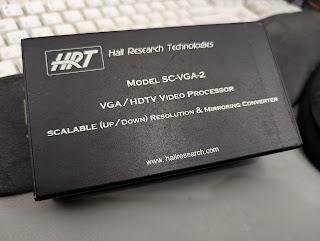While you might be able to trick the hardware into emitting a compatible signal, that's not good enough or even possible with several of my machines. Previously my problem child was astro, my SAIC Galaxy 1100, a modified PA-RISC HP 9000/712 crammed into a MIL-SPEC portable case with a fabulous built-in flat panel. These machines ran HP-UX 10.10 in their original heyday, but this particular system runs NeXTSTEP 3.3 for PA-RISC during the brief period of time NeXT supported the architecture and was a big hit at the Vintage Computer Festival West a few years ago. Its flat panel runs at an odd 62Hz and the external VGA port only generates a 60Hz signal for 640x480 (all other resolutions use different refresh rates), which is hopeless for running NeXTSTEP. However, now I have a new candidate I'd like to get some grabs off: a particularly problematic member of the Atari ST family which has been the subject of a long-running and highly frustrating extended Refurb Weekend. You'll get to meet this bad girl soon enough. The standard ST high resolution mode is 640x400 — at 71.2Hz. I can get a picture from it with my trusty NEC flat panel, but not with the Inogeni.
The usual solution to this is a scan converter, but those can be expensive and inconvenient. Here's one I picked up used on eBay for $2. Yes, really. It cost more to ship it.
This is the Hall Research Technologies SC-VGA-2, sold as a "VGA/HDTV Video Processor." In addition to slicing, dicing and pureeing, apparently, it will take any of a bundle of input formats and both rescale and resample them on the fly into the VGA or HDTV signal you desire, including 60Hz rates. This came from a seller specializing in teleprompter equipment and Hall still sells an HDMI version with additional resolutions ... for around US$500. However, this or the slightly newer SC-VGA-2A and SC-VGA-2B are all relatively common devices and found substantially cheaper used. Let's try it out and show some sample output, including those delicious NeXTSTEP system messages and some ST grabs.


